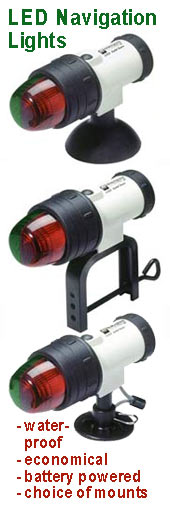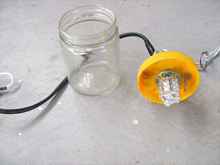
 Custom Search
|
|
| sails |
| plans |
| epoxy |
| rope/line |
| hardware |
| canoe/Kayak |
| sailmaking |
| materials |
| models |
| media |
| tools |
| gear |
 |
 |
| join |
| home |
| indexes |
| classifieds |
| calendar |
| archives |
| about |
| links |
| Join Duckworks Get free newsletter Comment on articles CLICK HERE |
|
|
| I Needed an Anchor Light! |
by John Welsford - Hamiliton - New Zealand |
Cruising in small open boats, or even big open boats often brings up unexpected challenges. One that I came across very recently was that while planning an eight day cruise, where I expected to be overnighting at anchor, I went and got my old hurricane type kerosene lamp out to find out that the rust had finally got it. Now that’s not really a big deal, they don’t cost much and it had done close to 10 years service, but I do need an anchor light, not just because I am supposed to have one, but because there are people motoring their big boats into the sheltered anchorages at night. They're often coming into the harbour in marginal visibility due to rain or heavy cloud, and I would prefer that they see me rather than run over me. Now once upon a time I used kerosene for both cooking and lighting, but with my little galley stove now fuelled with propane I’m down to one use of kerosene on the boat, and have to carry a separate fuel just for that, so in the interests of simplicity I decided that the spare motorbike battery that I’ve been assiduously maintaining would be the basis of an electric system. Neither of my boats, the cabin equipped one I’m going cruising in nor the open boat that I sometimes use, have electrical systems of any kind, no wires, no switches, no generation capacity, no lights no nothing. Just a big torch. Thomas Edison and Nicolai Tesla would be lost! With no wiring in the mast of either boat, and lacings on one hand and hoops on the other making it impractical to run a pair of wires up to the masthead, the anchor light has to be hung in the rigging. No problem there, just clip it on with a shackle, pull it up the forestay with the jib halyard, and put a line from the light down to the forestay fitting with which to retrieve it. Put the lamp on a length of twin core automotive wire, a pair of biggish alligator clips on one end to connect to the battery, and, and, the light? So! Off to the local electronics store which is much like the Radio Shack shops in the USA and bought a 12 volt LED array. Its got 12 LEDs arranged in a cluster and has a parallel pin base that goes into a standard auto light socket. The LEDs were about $15, that’s expensive compared to a standard light bulb, but cheap for the amount of light it puts out. It’s also very cheap for the amount of light for the current draw which is in this case 125 milliamps. The man at the shop tells me that motorbike battery will run this lamp 24 hours a day for about 2 or 3 weeks, I only need it for about 10% of that but its nice to have some reserve capacity. So I’ve got a light source, a socket cost me $4.50 at an auto parts outfit, the 6 metres of cord about another $15 and the alligator clips $5.50.
The LEDs need to be protected in an outside environment, as do the connections, and our local navigation light place charges rather a lot for lamps, and there are not any of suitable configuration so after scratching around in the cupboard I had a peanut butter sandwich, a very generous one that emptied the plastic lidded glass 300ml jar, washed it out and took the label off, cut a snug fitting hole in the lid for the light socket, and a pair of smaller holes for a loop of rope from which to hang the finished item. Contact cement held the lamp into the lid, then a layer of polyurethane construction glue covered the socket and the soldered and taped wire connections, and the lid was screwed back on, clipped on, and voila! Let there be light he said! There sure was, and you could see the thing for miles! Good, that’s another job done. Sure there was $40 in the job. But half of that was just to get the current from the battery to the lamp and I’d need that in any case, and a good marine LED anchor light is a lot more than that, plus the job is done. That lamp by the way works very well in the cabin, and I’d recommend it as an alternative should the prices of the “real” lamps shock you. Now that I have a battery all mounted up (in a little plywood box with a strap holding it all down so it cant move), the rot has started, there will be an electrical system. Radio and CD player, cabin lights for reading, and navigation lights. Legally, I can just carry a big torch when under sail, but if I’ve got electricity available I may as well do it properly so I’ll use a set of very nice LED navigation lights I got from from duckworksmagazine a while back, and will be getting a small connection board and a couple of switches to complete the system, plus some more LED arrays so I can have enough lighting inside that little cabin to enjoy a book of an evening. Might even get one of those flexible solar cells that can be rolled up and put away when not in use. Luxury, who knows, gold plated taps may be just around the corner. |
 |


